VOLVO V90 2017 Owners Manual
Manufacturer: VOLVO, Model Year: 2017, Model line: V90, Model: VOLVO V90 2017Pages: 594, PDF Size: 15.07 MB
Page 331 of 594
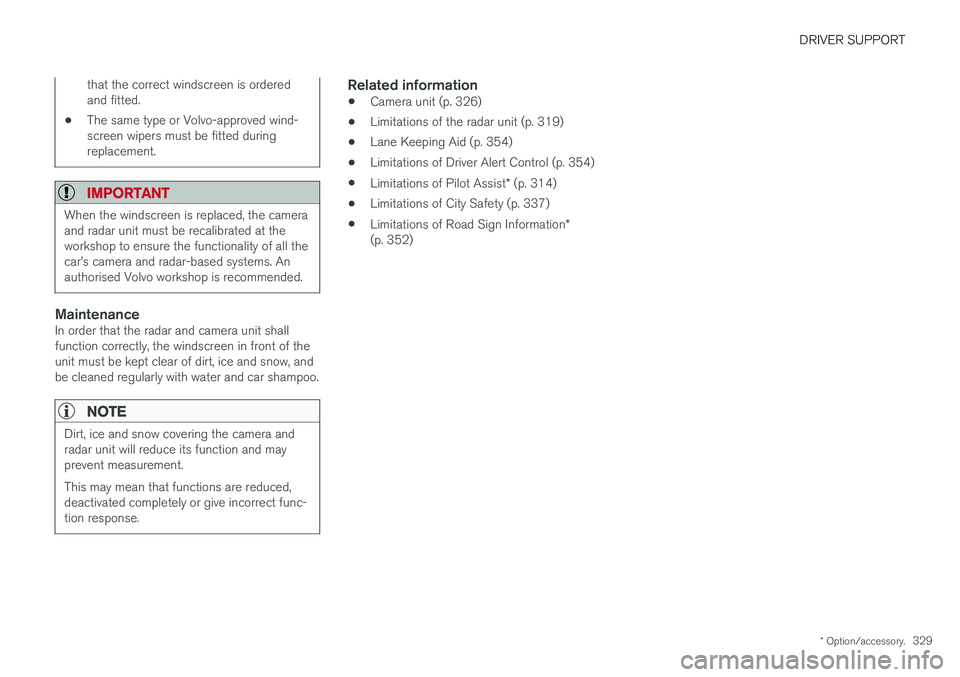
DRIVER SUPPORT
* Option/accessory.329
that the correct windscreen is ordered and fitted.
• The same type or Volvo-approved wind-screen wipers must be fitted duringreplacement.
IMPORTANT
When the windscreen is replaced, the camera and radar unit must be recalibrated at theworkshop to ensure the functionality of all thecar
Page 332 of 594
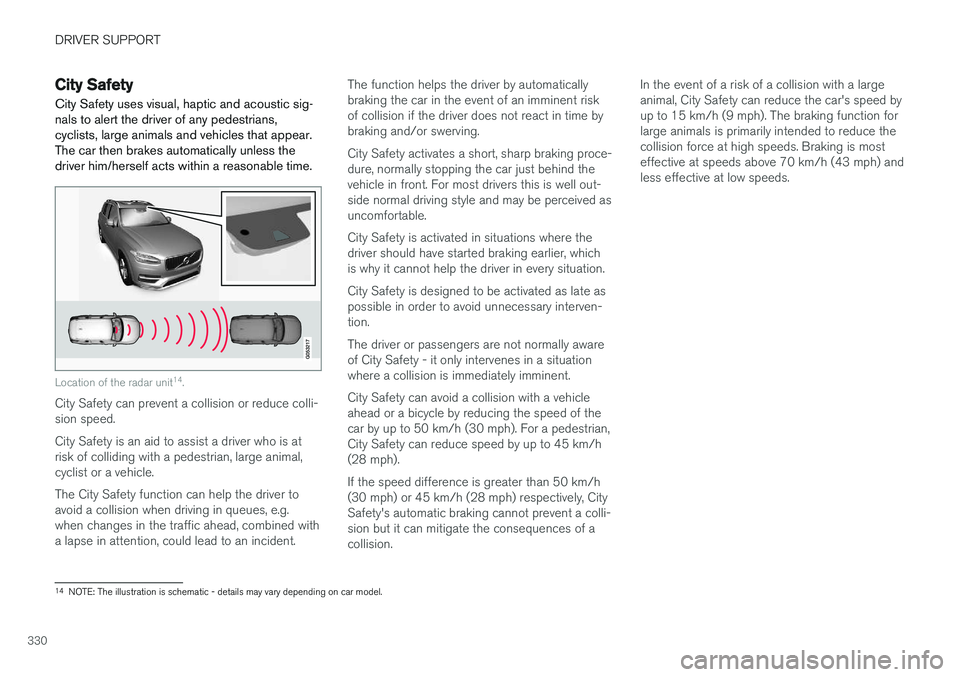
DRIVER SUPPORT
330
City Safety
City Safety uses visual, haptic and acoustic sig- nals to alert the driver of any pedestrians,cyclists, large animals and vehicles that appear.The car then brakes automatically unless thedriver him/herself acts within a reasonable time.
Location of the radar unit 14
.
City Safety can prevent a collision or reduce colli- sion speed. City Safety is an aid to assist a driver who is at risk of colliding with a pedestrian, large animal,cyclist or a vehicle. The City Safety function can help the driver to avoid a collision when driving in queues, e.g.when changes in the traffic ahead, combined witha lapse in attention, could lead to an incident. The function helps the driver by automaticallybraking the car in the event of an imminent riskof collision if the driver does not react in time bybraking and/or swerving. City Safety activates a short, sharp braking proce- dure, normally stopping the car just behind thevehicle in front. For most drivers this is well out-side normal driving style and may be perceived asuncomfortable. City Safety is activated in situations where the driver should have started braking earlier, whichis why it cannot help the driver in every situation. City Safety is designed to be activated as late as possible in order to avoid unnecessary interven-tion. The driver or passengers are not normally aware of City Safety - it only intervenes in a situationwhere a collision is immediately imminent. City Safety can avoid a collision with a vehicle ahead or a bicycle by reducing the speed of thecar by up to 50 km/h (30 mph). For a pedestrian,City Safety can reduce speed by up to 45 km/h(28 mph). If the speed difference is greater than 50 km/h (30 mph) or 45 km/h (28 mph) respectively, CitySafety's automatic braking cannot prevent a colli-sion but it can mitigate the consequences of acollision.In the event of a risk of a collision with a largeanimal, City Safety can reduce the car's speed byup to 15 km/h (9 mph). The braking function forlarge animals is primarily intended to reduce thecollision force at high speeds. Braking is mosteffective at speeds above 70 km/h (43 mph) andless effective at low speeds.
14
NOTE: The illustration is schematic - details may vary depending on car model.
Page 333 of 594
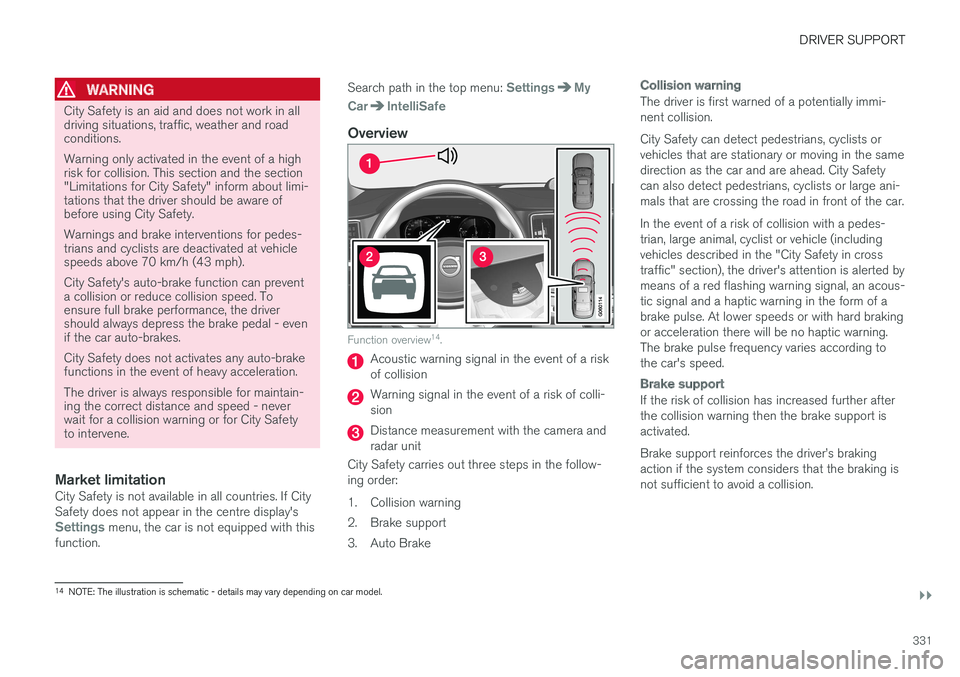
DRIVER SUPPORT
}}
331
WARNING
City Safety is an aid and does not work in all driving situations, traffic, weather and roadconditions. Warning only activated in the event of a high risk for collision. This section and the section"Limitations for City Safety" inform about limi-tations that the driver should be aware ofbefore using City Safety. Warnings and brake interventions for pedes- trians and cyclists are deactivated at vehiclespeeds above 70 km/h (43 mph). City Safety's auto-brake function can prevent a collision or reduce collision speed. Toensure full brake performance, the drivershould always depress the brake pedal - evenif the car auto-brakes. City Safety does not activates any auto-brake functions in the event of heavy acceleration. The driver is always responsible for maintain- ing the correct distance and speed - neverwait for a collision warning or for City Safetyto intervene.
Market limitationCity Safety is not available in all countries. If City Safety does not appear in the centre display's
Settings menu, the car is not equipped with this
function. Search path in the top menu:
SettingsMy
Car
IntelliSafe
Overview
Function overview 14
.
Acoustic warning signal in the event of a risk of collision
Warning signal in the event of a risk of colli- sion
Distance measurement with the camera and radar unit
City Safety carries out three steps in the follow-ing order:
1. Collision warning
2. Brake support
3. Auto Brake
Collision warning
The driver is first warned of a potentially immi- nent collision. City Safety can detect pedestrians, cyclists or vehicles that are stationary or moving in the samedirection as the car and are ahead. City Safetycan also detect pedestrians, cyclists or large ani-mals that are crossing the road in front of the car. In the event of a risk of collision with a pedes- trian, large animal, cyclist or vehicle (includingvehicles described in the "City Safety in crosstraffic" section), the driver's attention is alerted bymeans of a red flashing warning signal, an acous-tic signal and a haptic warning in the form of abrake pulse. At lower speeds or with hard brakingor acceleration there will be no haptic warning.The brake pulse frequency varies according tothe car's speed.
Brake support
If the risk of collision has increased further after the collision warning then the brake support isactivated. Brake support reinforces the driver
Page 334 of 594
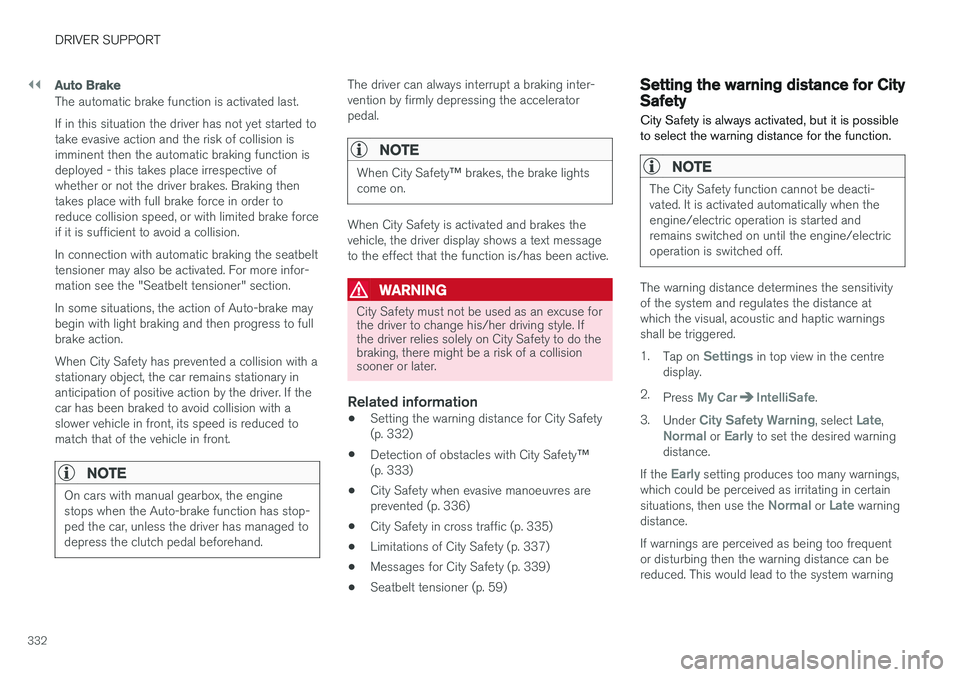
||
DRIVER SUPPORT
332
Auto Brake
The automatic brake function is activated last. If in this situation the driver has not yet started to take evasive action and the risk of collision isimminent then the automatic braking function isdeployed - this takes place irrespective ofwhether or not the driver brakes. Braking thentakes place with full brake force in order toreduce collision speed, or with limited brake forceif it is sufficient to avoid a collision. In connection with automatic braking the seatbelt tensioner may also be activated. For more infor-mation see the "Seatbelt tensioner" section. In some situations, the action of Auto-brake may begin with light braking and then progress to fullbrake action. When City Safety has prevented a collision with a stationary object, the car remains stationary inanticipation of positive action by the driver. If thecar has been braked to avoid collision with aslower vehicle in front, its speed is reduced tomatch that of the vehicle in front.
NOTE
On cars with manual gearbox, the engine stops when the Auto-brake function has stop-ped the car, unless the driver has managed todepress the clutch pedal beforehand.
The driver can always interrupt a braking inter- vention by firmly depressing the acceleratorpedal.
NOTE
When City Safety™ brakes, the brake lights
come on.
When City Safety is activated and brakes the vehicle, the driver display shows a text messageto the effect that the function is/has been active.
WARNING
City Safety must not be used as an excuse for the driver to change his/her driving style. Ifthe driver relies solely on City Safety to do thebraking, there might be a risk of a collisionsooner or later.
Related information
• Setting the warning distance for City Safety (p. 332)
• Detection of obstacles with City Safety
™
(p. 333)
• City Safety when evasive manoeuvres areprevented (p. 336)
• City Safety in cross traffic (p. 335)
• Limitations of City Safety (p. 337)
• Messages for City Safety (p. 339)
• Seatbelt tensioner (p. 59)
Setting the warning distance for City Safety
City Safety is always activated, but it is possible to select the warning distance for the function.
NOTE
The City Safety function cannot be deacti- vated. It is activated automatically when theengine/electric operation is started andremains switched on until the engine/electricoperation is switched off.
The warning distance determines the sensitivity of the system and regulates the distance atwhich the visual, acoustic and haptic warningsshall be triggered. 1. Tap on
Settings in top view in the centre
display.
2. Press
My CarIntelliSafe.
3. Under
City Safety Warning, select Late,Normal or Early to set the desired warning
distance.
If the
Early setting produces too many warnings,
which could be perceived as irritating in certain situations, then use the
Normal or Late warning
distance. If warnings are perceived as being too frequent or disturbing then the warning distance can bereduced. This would lead to the system warning
Page 335 of 594
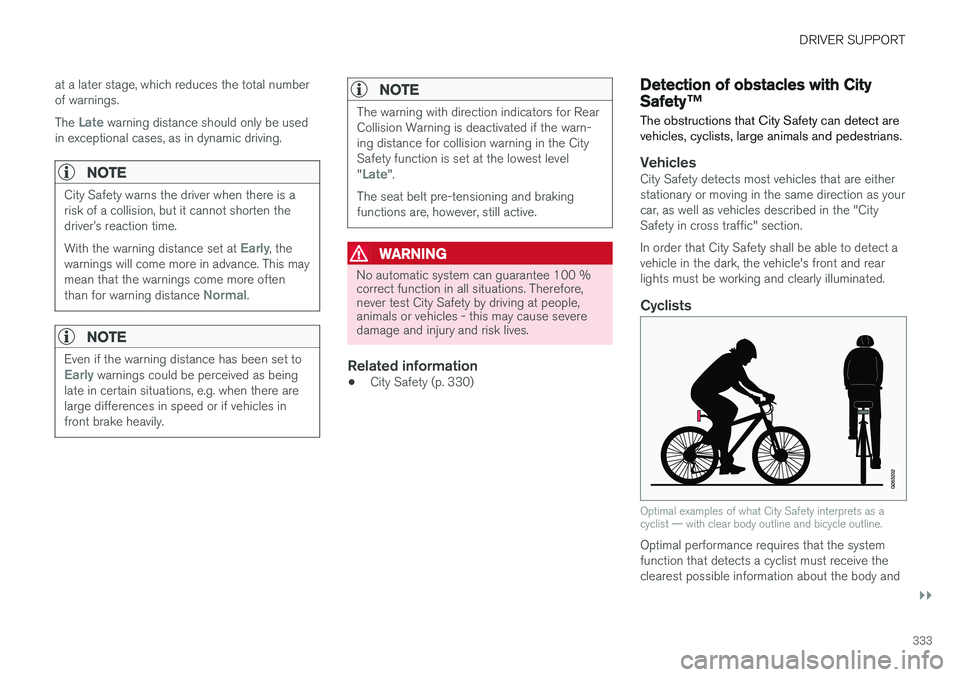
DRIVER SUPPORT
}}
333
at a later stage, which reduces the total number of warnings. The
Late warning distance should only be used
in exceptional cases, as in dynamic driving.
NOTE
City Safety warns the driver when there is a risk of a collision, but it cannot shorten thedriver
Page 336 of 594
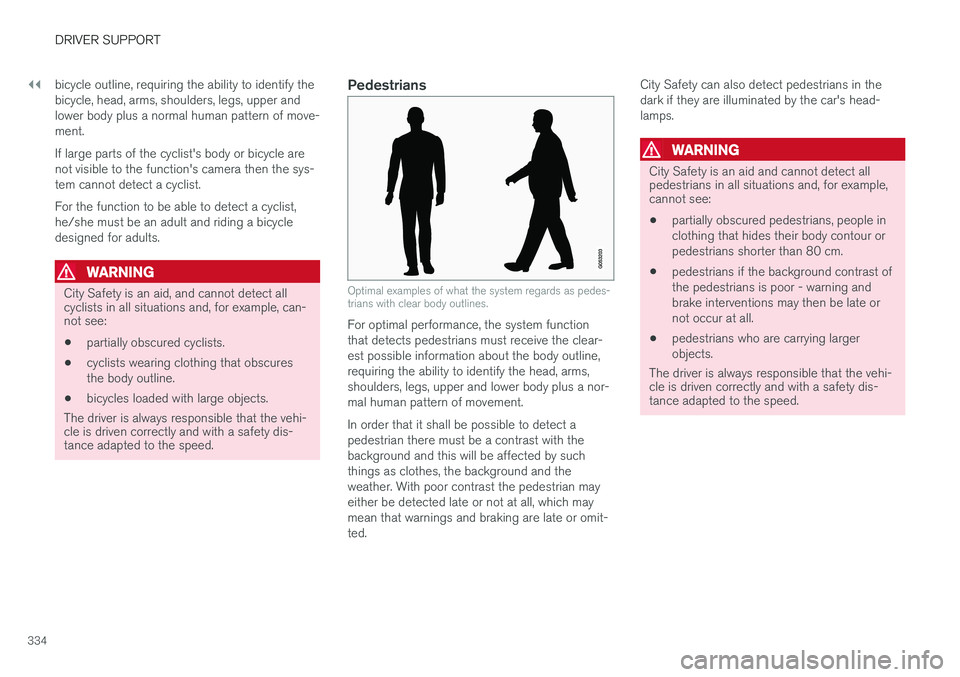
||
DRIVER SUPPORT
334bicycle outline, requiring the ability to identify the bicycle, head, arms, shoulders, legs, upper andlower body plus a normal human pattern of move-ment. If large parts of the cyclist's body or bicycle are not visible to the function's camera then the sys-tem cannot detect a cyclist. For the function to be able to detect a cyclist, he/she must be an adult and riding a bicycledesigned for adults.
WARNING
City Safety is an aid, and cannot detect all cyclists in all situations and, for example, can-not see: •
partially obscured cyclists.
• cyclists wearing clothing that obscures the body outline.
• bicycles loaded with large objects.
The driver is always responsible that the vehi- cle is driven correctly and with a safety dis-tance adapted to the speed.
Pedestrians
Optimal examples of what the system regards as pedes- trians with clear body outlines.
For optimal performance, the system function that detects pedestrians must receive the clear-est possible information about the body outline,requiring the ability to identify the head, arms,shoulders, legs, upper and lower body plus a nor-mal human pattern of movement. In order that it shall be possible to detect a pedestrian there must be a contrast with thebackground and this will be affected by suchthings as clothes, the background and theweather. With poor contrast the pedestrian mayeither be detected late or not at all, which maymean that warnings and braking are late or omit-ted. City Safety can also detect pedestrians in thedark if they are illuminated by the car's head-lamps.
WARNING
City Safety is an aid and cannot detect all pedestrians in all situations and, for example,cannot see:
• partially obscured pedestrians, people in clothing that hides their body contour orpedestrians shorter than 80 cm.
• pedestrians if the background contrast ofthe pedestrians is poor - warning andbrake interventions may then be late ornot occur at all.
• pedestrians who are carrying largerobjects.
The driver is always responsible that the vehi-
cle is driven correctly and with a safety dis- tance adapted to the speed.
Page 337 of 594
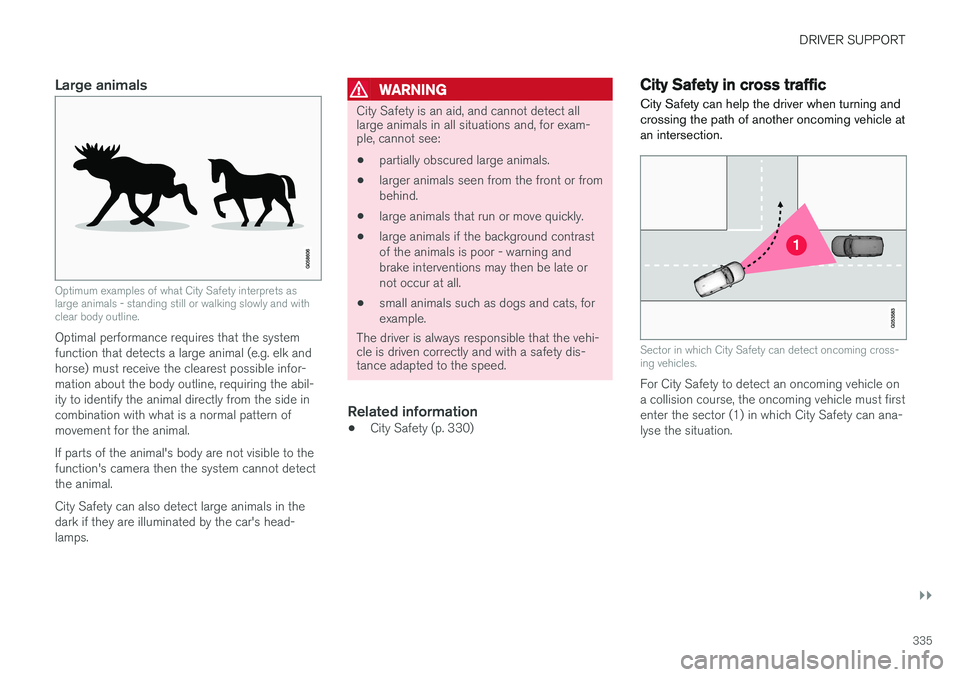
DRIVER SUPPORT
}}
335
Large animals
Optimum examples of what City Safety interprets as large animals - standing still or walking slowly and withclear body outline.
Optimal performance requires that the system function that detects a large animal (e.g. elk andhorse) must receive the clearest possible infor-mation about the body outline, requiring the abil-ity to identify the animal directly from the side incombination with what is a normal pattern ofmovement for the animal. If parts of the animal's body are not visible to the function's camera then the system cannot detectthe animal. City Safety can also detect large animals in the dark if they are illuminated by the car's head-lamps.
WARNING
City Safety is an aid, and cannot detect all large animals in all situations and, for exam-ple, cannot see:
• partially obscured large animals.
• larger animals seen from the front or from behind.
• large animals that run or move quickly.
• large animals if the background contrastof the animals is poor - warning andbrake interventions may then be late ornot occur at all.
• small animals such as dogs and cats, forexample.
The driver is always responsible that the vehi- cle is driven correctly and with a safety dis-tance adapted to the speed.
Related information
• City Safety (p. 330)
City Safety in cross traffic
City Safety can help the driver when turning and crossing the path of another oncoming vehicle atan intersection.
Sector in which City Safety can detect oncoming cross- ing vehicles.
For City Safety to detect an oncoming vehicle on a collision course, the oncoming vehicle must firstenter the sector (1) in which City Safety can ana-lyse the situation.
Page 338 of 594
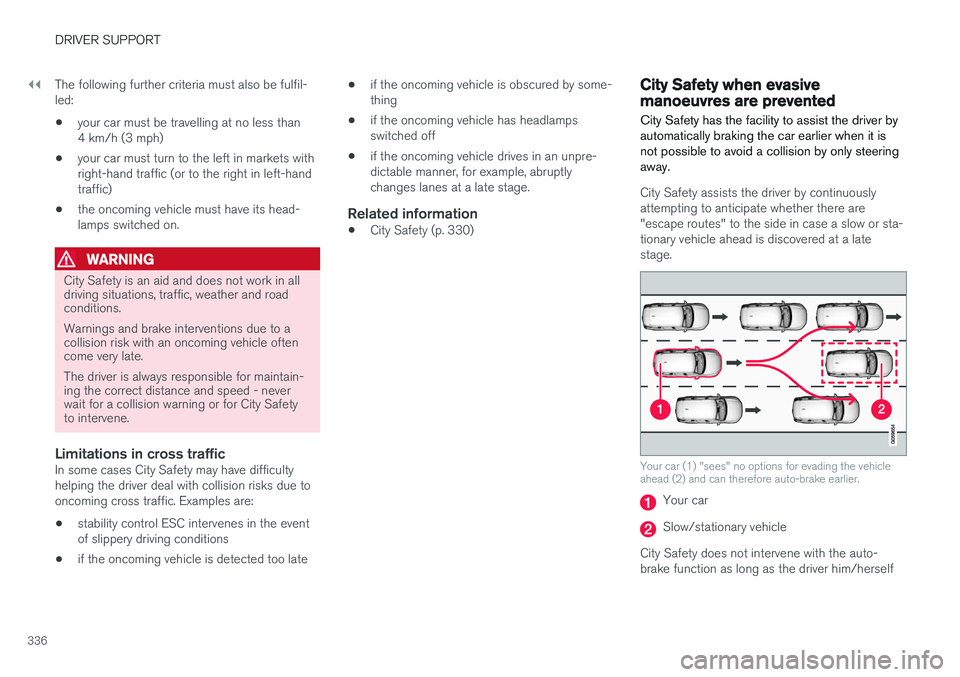
||
DRIVER SUPPORT
336The following further criteria must also be fulfil- led:
• your car must be travelling at no less than4 km/h (3 mph)
• your car must turn to the left in markets withright-hand traffic (or to the right in left-handtraffic)
• the oncoming vehicle must have its head-lamps switched on.
WARNING
City Safety is an aid and does not work in all driving situations, traffic, weather and roadconditions. Warnings and brake interventions due to a collision risk with an oncoming vehicle oftencome very late. The driver is always responsible for maintain- ing the correct distance and speed - neverwait for a collision warning or for City Safetyto intervene.
Limitations in cross trafficIn some cases City Safety may have difficulty helping the driver deal with collision risks due tooncoming cross traffic. Examples are:
• stability control ESC intervenes in the eventof slippery driving conditions
• if the oncoming vehicle is detected too late •
if the oncoming vehicle is obscured by some-thing
• if the oncoming vehicle has headlampsswitched off
• if the oncoming vehicle drives in an unpre-dictable manner, for example, abruptlychanges lanes at a late stage.
Related information
•
City Safety (p. 330)
City Safety when evasive manoeuvres are prevented City Safety has the facility to assist the driver by automatically braking the car earlier when it isnot possible to avoid a collision by only steeringaway.
City Safety assists the driver by continuously attempting to anticipate whether there are"escape routes" to the side in case a slow or sta-tionary vehicle ahead is discovered at a latestage.
Your car (1) "sees" no options for evading the vehicle ahead (2) and can therefore auto-brake earlier.
Your car
Slow/stationary vehicle
City Safety does not intervene with the auto- brake function as long as the driver him/herself
Page 339 of 594
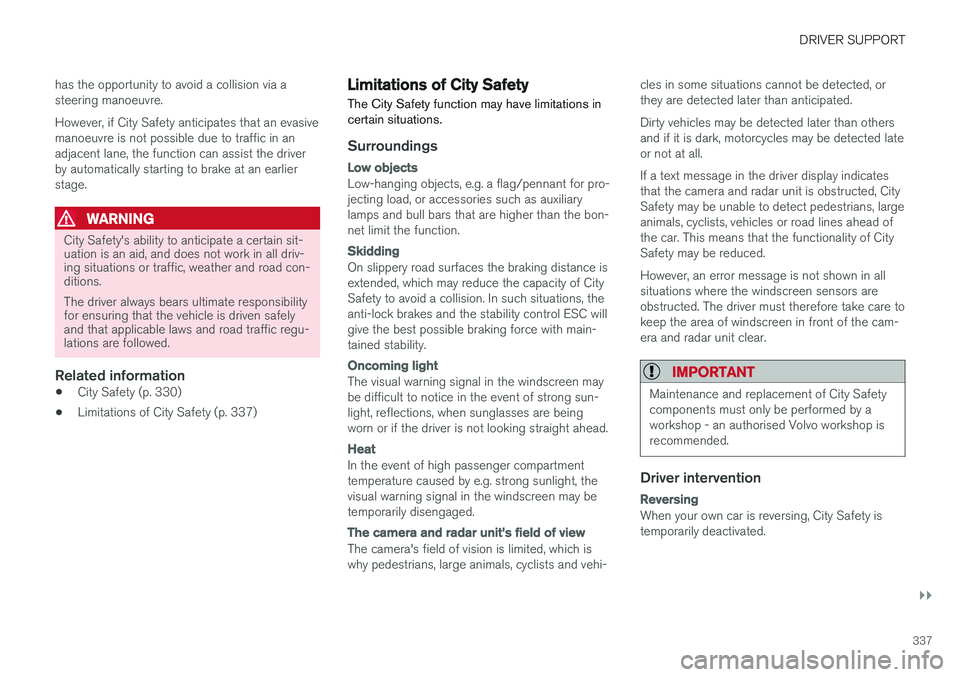
DRIVER SUPPORT
}}
337
has the opportunity to avoid a collision via a steering manoeuvre. However, if City Safety anticipates that an evasive manoeuvre is not possible due to traffic in anadjacent lane, the function can assist the driverby automatically starting to brake at an earlierstage.
WARNING
City Safety's ability to anticipate a certain sit- uation is an aid, and does not work in all driv-ing situations or traffic, weather and road con-ditions. The driver always bears ultimate responsibility for ensuring that the vehicle is driven safelyand that applicable laws and road traffic regu-lations are followed.
Related information
•
City Safety (p. 330)
• Limitations of City Safety (p. 337)
Limitations of City Safety
The City Safety function may have limitations in certain situations.
Surroundings
Low objects
Low-hanging objects, e.g. a flag/pennant for pro- jecting load, or accessories such as auxiliarylamps and bull bars that are higher than the bon-net limit the function.
Skidding
On slippery road surfaces the braking distance is extended, which may reduce the capacity of CitySafety to avoid a collision. In such situations, theanti-lock brakes and the stability control ESC willgive the best possible braking force with main-tained stability.
Oncoming light
The visual warning signal in the windscreen may be difficult to notice in the event of strong sun-light, reflections, when sunglasses are beingworn or if the driver is not looking straight ahead.
Heat
In the event of high passenger compartment temperature caused by e.g. strong sunlight, thevisual warning signal in the windscreen may betemporarily disengaged.
The camera and radar unit's field of view
The camera's field of vision is limited, which is why pedestrians, large animals, cyclists and vehi- cles in some situations cannot be detected, orthey are detected later than anticipated. Dirty vehicles may be detected later than others and if it is dark, motorcycles may be detected lateor not at all. If a text message in the driver display indicates that the camera and radar unit is obstructed, CitySafety may be unable to detect pedestrians, largeanimals, cyclists, vehicles or road lines ahead ofthe car. This means that the functionality of CitySafety may be reduced. However, an error message is not shown in all situations where the windscreen sensors areobstructed. The driver must therefore take care tokeep the area of windscreen in front of the cam-era and radar unit clear.
IMPORTANT
Maintenance and replacement of City Safety components must only be performed by aworkshop - an authorised Volvo workshop isrecommended.
Driver intervention
Reversing
When your own car is reversing, City Safety is temporarily deactivated.
Page 340 of 594
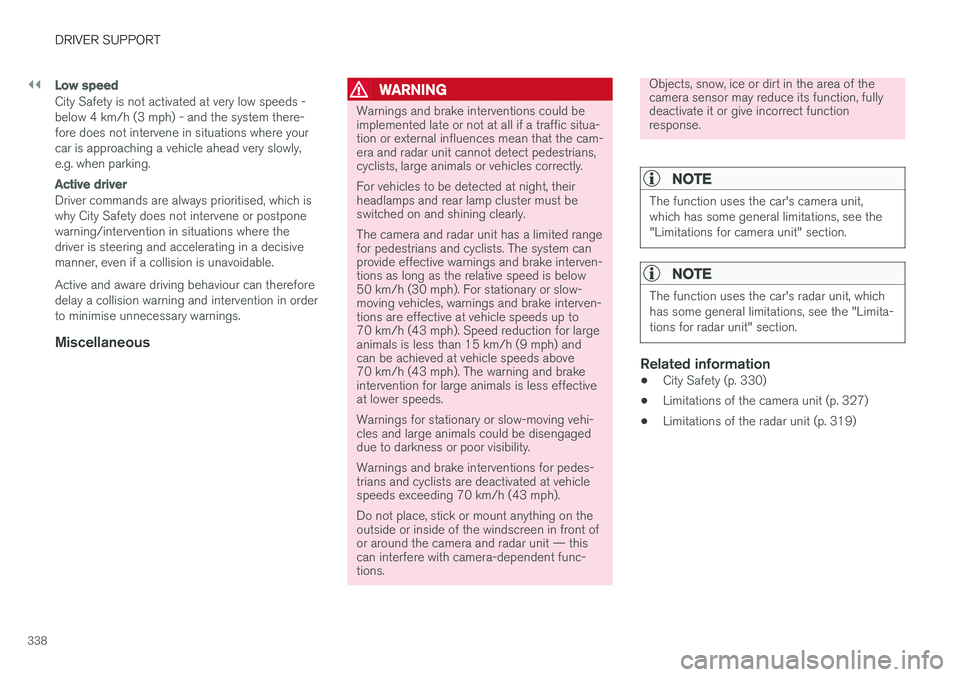
||
DRIVER SUPPORT
338
Low speed
City Safety is not activated at very low speeds - below 4 km/h (3 mph) - and the system there-fore does not intervene in situations where yourcar is approaching a vehicle ahead very slowly,e.g. when parking.
Active driver
Driver commands are always prioritised, which is why City Safety does not intervene or postponewarning/intervention in situations where thedriver is steering and accelerating in a decisivemanner, even if a collision is unavoidable. Active and aware driving behaviour can therefore delay a collision warning and intervention in orderto minimise unnecessary warnings.
Miscellaneous
WARNING
Warnings and brake interventions could be implemented late or not at all if a traffic situa-tion or external influences mean that the cam-era and radar unit cannot detect pedestrians,cyclists, large animals or vehicles correctly. For vehicles to be detected at night, their headlamps and rear lamp cluster must beswitched on and shining clearly. The camera and radar unit has a limited range for pedestrians and cyclists. The system canprovide effective warnings and brake interven-tions as long as the relative speed is below50 km/h (30 mph). For stationary or slow-moving vehicles, warnings and brake interven-tions are effective at vehicle speeds up to70 km/h (43 mph). Speed reduction for largeanimals is less than 15 km/h (9 mph) andcan be achieved at vehicle speeds above70 km/h (43 mph). The warning and brakeintervention for large animals is less effectiveat lower speeds. Warnings for stationary or slow-moving vehi- cles and large animals could be disengageddue to darkness or poor visibility. Warnings and brake interventions for pedes- trians and cyclists are deactivated at vehiclespeeds exceeding 70 km/h (43 mph). Do not place, stick or mount anything on the outside or inside of the windscreen in front ofor around the camera and radar unit — thiscan interfere with camera-dependent func-tions.
Objects, snow, ice or dirt in the area of the camera sensor may reduce its function, fullydeactivate it or give incorrect functionresponse.
NOTE
The function uses the car's camera unit, which has some general limitations, see the"Limitations for camera unit" section.
NOTE
The function uses the car's radar unit, which has some general limitations, see the "Limita-tions for radar unit" section.
Related information
•City Safety (p. 330)
• Limitations of the camera unit (p. 327)
• Limitations of the radar unit (p. 319)